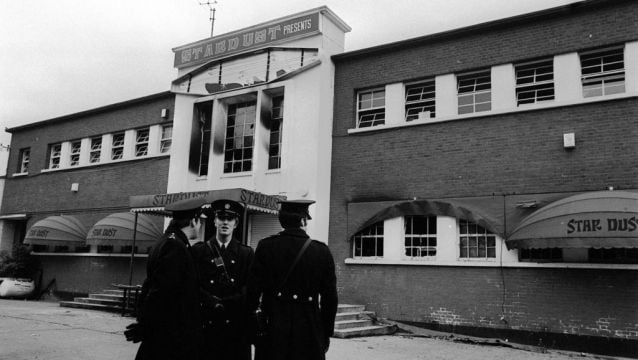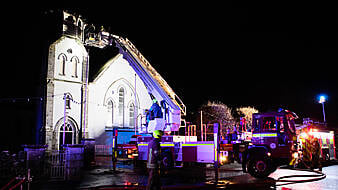An inquest jury has begun hearing details of the causes of death of those who lost their lives in the Stardust nightclub fire, with high levels of carbon monoxide found in many of the victims and inhalation of fire fumes and heat identified as the cause of death.
Coroner Dr Myra Cullinane on Wednesday told the jury in the Dublin District Coroner's Court that their role was to determine the date of death, the place of death and the cause of death of each of the victims, as pathological evidence was given by consultant forensic pathologists Doctor Richard Shepherd, Doctor Nat Carey, and Doctor Benjamin Swift.
Dr Cullinane said that this evidence would be very difficult for the victims’ families to hear, and the experts would make themselves available to the families if they wished.
Dr Shepherd said he and his colleagues had been provided with the original postmortem reports and toxicology reports and photos taken at the time, as well as other details, of the 48 people who were killed when fire consumed the Stardust nightclub in the early hours of Valentine’s Day, 1981.
The victims will be dealt with alphabetically, and the first evidence the jury heard related to Michael Barrett, who was 17 at the time of his death.
Toxic fumes
A member of the coroner’s legal team, Simon Mills SC referred to the original postmortem report on Michael Barrett, which indicated that he had been exposed to significant toxic fumes.
Dr Shepherd told the jury that the cause of death was the inhalation of fire fumes, confirming that carbon monoxide was present at a level of 50%. He also said that Michael suffered extensive charring and heat fractures, but it was not possible to determine if these were caused before or after death.
Dr Cullinane said that the families of the victims might like to know if the presence of obvious inhalation of fumes indicated some diminution of suffering, to which Dr Shepherd said that diminution of consciousness is one of the effects of the inhalation of these gases, so it was quite likely that this happened in this case.
The next deceased the jury heard evidence of was Richard Bennett, who remained unidentified until 2007, when anthropological and forensic science evidence identified him after the exhumation of his remains.
He was aged 17 at the time of his death.
Mr Mills said there was evidence of the inhalation of toxic and noxious substances, evidence of the inhalation of significant amounts of carbon monoxide and hydrogen cyanide, and evidence of exposure to significant heat.
Dr Shepherd confirmed that the cause of death was rapid incapacitation due to inhalation of fire fumes and heat.
Pathological evidence
During the pathological evidence relating to Carol Bissett, the jury heard a statement made by her father, Thomas Bissett, which was read into the record by the court registrar, in which Mr Bissett said he last saw his daughter at the Mater Hospital, where she was badly burnt and unable to speak as she was unconscious.
Carol was pronounced dead on the morning of February 18th 1981. She was 18 at the time of death.
Mr Mills said that there was evidence of some lung damage, which may have been attributable to heat injuries and fume inhalation.
Dr Shepherd confirmed that her death was due to complications of burns and the inhalation of fumes.
He said that the combination of injuries would almost certainly have been considered to be fatal when she was brought to hospital, but her absence of consciousness would have removed any perception of pain or distress.
The jury next heard that Jimmy Buckley, who was 23 at the time of his death, was found to have evidence of inhalation of noxious substances and soot in his airways.
Mr Mills said that toxicological reports indicated a measure of exposure to carbon monoxide, which on its own would not be expected to cause death, but there may have been other gases present.
Dr Shepherd confirmed that the cause of death was rapid incapacitation due to the inhalation of fire fumes and heat.
Paula Byrne, who was identified from her dental records and was 19 at the time of her death, was found to have a measurement of exposure to carbon monoxide to a level of 55 per cent, which confirmed her exposure to very high levels.
Dr Shepherd confirmed that her death was due to the inhalation of fire fumes. He said that a level of 30 per cent could result in a loss of consciousness, while anything of 50 per cent or above is very likely to be fatal.
He confirmed to Michael O’Higgins SC, representing Paula’s family, that there would be a loss of consciousness and “mercifully” a loss of perception.
The jury next heard that Caroline Carey, who was 17 at the time of her death, was pronounced dead at the hospital. Mr Mills said that resuscitation measures were attempted on Caroline, so there may be scope for concluding that her place of death was where death was pronounced and not the Stardust.
“Yes, you’re not officially dead until someone says you are, to put it quite crudely,” said Dr Swift, going on to confirm that the cause of death was rapid incapacitation due to inhalation of fire fumes and heat.
Brenda Campbell KC, representing Caroline's family, said that Caroline was pregnant at the time of her death.
She said that Caroline and her boyfriend attempted to make their way to an exit and were unable to access that, so her boyfriend took Caroline to the toilets in search of refuge and safety.
She asked Dr Shepherd if the consequences of going in there were that she was protected from the fire but not the noxious fumes, to which Dr Shepherd replied that there would not have been as much heat in that area, but the fumes she had inhaled on route would have continued to affect her.
The last pathology report the jury heard was that of John Colgan, who was 21 at the time of his death.
Mr Mills said there was smoke blackening of the airways, so significant products must have been inhaled, and there were extensive burns to the victim's head and neck, but it was hard to say if this happened before or after death.
Dr Shepherd confirmed that the cause of death was rapid incapacitation due to inhalation of fire fumes and heat.
Earlier in the day, the three pathologists confirmed that all of the deceased would have been exposed to fire fumes, while Dr Carey said that the levels of carbon monoxide in some of the deceased indicated to him that they may have died pretty rapidly, and there was not enough time to breath in and get higher levels.
All three confirmed that in all 48 deaths, all were exposed to an inhaled fumes atmosphere and a heated environment that was a causative factor in death.
The experts also said that, despite the difficulties of looking back at these deaths 42 years later, they had reached a broad agreement on the causes of death of each victim.
The inquest continues on Thursday in the Pillar Room of the Rotunda Hospital, when the jury will hear further pathology evidence relating to those who died.







